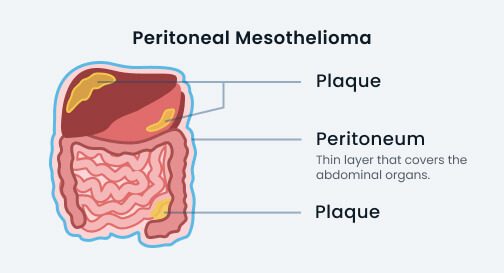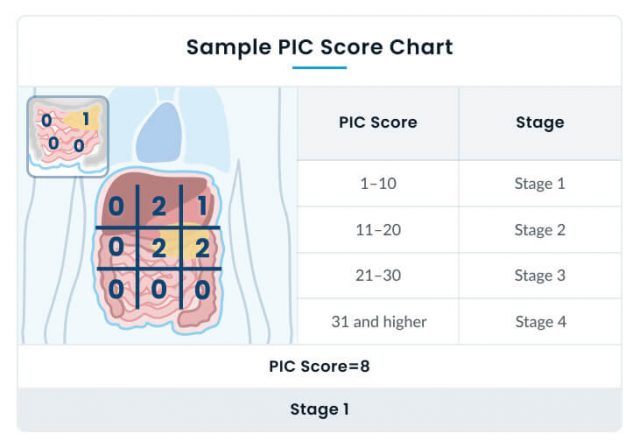Peritoneal Mesothelioma Cancer
Peritoneal mesothelioma is cancer that forms in the tissue lining the abdomen and abdominal organs. Ingesting asbestos fibers causes a chronic inflammatory immune response that leads to the development of tumors years later. Treatment with cytoreductive surgery and heated chemotherapy may extend life expectancy beyond the average of one year.
What Is Peritoneal Mesothelioma?

Mesothelioma cancer that forms on the abdominal lining is known as peritoneal mesothelioma. Inhaling or ingesting asbestos fibers can trap them in the tissue that lines the abdominal cavity and organs. Tumors form after years of tissue irritation and inflammation, and the disease can be challenging to diagnose.
The most effective method of treating malignant peritoneal mesothelioma is a combination of surgery and heated chemotherapy. Heated intraperitoneal chemotherapy, known as HIPEC, has increased survival in many patients by over 10 years.
- The peritoneal form of mesothelioma makes up about 15% to 20% of all cases, which is approximately 500 to 600 people per year.
- Early symptoms include abdominal pain or swelling and gastrointestinal issues, such as constipation or diarrhea.
- Asbestos fibers enter the peritoneal tissue through the digestive system after inhaling or swallowing them into the stomach.
- The most effective treatment is surgery combined with heated chemotherapy.
- Average life expectancy is approximately 12 months.
- With surgery, over half of patients live five years or more after diagnosis, much longer than those with pleural mesothelioma.
Symptoms of Peritoneal Mesothelioma
Most patients experience early peritoneal mesothelioma symptoms that mimic mild abdominal or gastrointestinal distress. Many symptoms do not appear until several decades after initial exposure to asbestos, sometimes up to 50 years later.
Common Peritoneal Mesothelioma Symptoms
- Abdominal pain or discomfort
- Abdominal swelling
- Constipation
- Diarrhea
- Nausea
- Vomiting
- Weight loss
- Fever
- Night sweats
- Anemia (decreased red blood cells)
- Hypercoagulability (increased risk of blood clots)
- Small bowel obstruction, or blockage in the small intestine
Many symptoms are similar to those in chronic gastrointestinal inflammatory conditions, such as colitis or diverticulitis, which can lead to misdiagnosis.

Causes & Risk Factors for Peritoneal Mesothelioma
Peritoneal mesothelioma is caused by ingesting asbestos fibers. The most likely path into the abdominal tissue is through the digestive system. The body’s immune system cannot expel or degrade the asbestos fibers, and they become trapped, irritating the tissue.
As the immune system attacks the asbestos fibers trapped in the peritoneum, the years of repeated inflammation lead to scar tissue formation and damaged cells. The cellular DNA in the peritoneal tissue becomes more prone to mutations, and tumors begin to form.
- Swallowed or inhaled asbestos fibers enter the digestive system.
- The fibers move through the lymphatic system into the peritoneal tissue that lines the abdomen and abdominal organs.
- Asbestos fibers trapped in the peritoneum irritate the cells through an inflammatory immune reaction.
- Prolonged irritation and inflammation damage the cells and DNA. Fluid and cellular waste accumulate in the abdomen.
- Increased fluid and cellular damage cause thickening of the peritoneal lining, and tumors eventually develop in the peritoneum.
Exposure to asbestos is the primary risk factor for peritoneal mesothelioma cancer. Research has indicated that other causes may include radiation to the abdomen (as a treatment for other cancers), genetic predisposition or DNA mutation.
Peritoneal Mesothelioma Prognosis & Survival Rates
Mesothelioma is an incurable cancer in all its forms, and the prognosis is generally poor. However, mesothelioma prognosis varies from one individual to another, and response to treatment is a primary determining factor for life expectancy.
Peritoneal mesothelioma patients face an average life expectancy of six to 12 months. Advanced treatment options can provide extended survival in many cases.
In general, life expectancy for malignant peritoneal mesothelioma patients is more favorable than in other types of the disease.
The most significant chance of prolonging survival is through surgery. About half of patients who are eligible for surgery with heated chemotherapy live longer than five years.
- Age
- Gender
- Tumor cell type
- Rate of cancer growth
- Treatment eligibility
- Cancer stage
- Genetic mutations
Women have a higher chance of extended survivability. On average, women live 13 months after diagnosis, while men live six months.
Patients with epithelial tumor cell type also have a longer life expectancy. Sarcomatoid or biphasic type tumors are more challenging to treat and may spread more quickly.
Peritoneal Mesothelioma Survival Rates
- 92% survived for at least one year
- 74% survived for three years
- 65% survived for five years
- 39% survived for 10 years or longer
Diagnosing Peritoneal Mesothelioma
Diagnosis typically begins with bloodwork and imaging that can rule out other diseases and types of cancer. CT scans and X-rays visualize the size and location of tumor masses in the abdomen. Blood tests look for biomarkers that can identify specific cancer types.
Physicians will also take a detailed medical and occupational history to determine possible sources of asbestos exposure. Identifying when and how much exposure occurred can be vital in obtaining an early diagnosis.
To confirm a diagnosis of malignant mesothelioma, doctors will need to perform a biopsy. Biopsies remove tissue or fluid samples to show pathologists what types of cells are present in the tumor and can determine the course of treatment.
Stages of Peritoneal Mesothelioma
Unlike pleural mesothelioma and other cancers, there is no official staging system for peritoneal mesothelioma. However, some criteria can identify stages of progression to determine if cancer has spread or metastasized to distant sites in the body.
Peritoneal mesothelioma stages can be loosely determined based on the extent of cancer within the abdomen. Stage 1 indicates that cancer has not spread beyond its point of origin. Stages 2 and 3 may show multiple tumors with some lymph node involvement.
Stage 4 mesothelioma most often designates metastasis to distant tissues and organs.
Peritoneal Cancer Index

Doctors can narrow down the cancer stage by using the Peritoneal Cancer Index. The PCI is a diagnostic tool that divides the abdomen into 13 regions.
By assigning each region a number from one to three based on the tumor size in that area, doctors designate a total score. The score indicates the peritoneal mesothelioma stage.
The maximum score is 39, and index scores higher than 20 indicate a likely inadequate response to surgery.
Misdiagnosis
Malignant peritoneal mesothelioma is a rare disease and often requires a specialist for diagnosis. Doctors without much experience treating mesothelioma may misdiagnose this cancer as a less severe abdominal issue, which can delay proper treatment.
The best way to ensure an accurate mesothelioma diagnosis is to find a specialist that has experience in treating patients with asbestos exposure. These doctors have the appropriate tools and knowledge to diagnose and treat early signs of peritoneal mesothelioma.

Treatment Options for Peritoneal Mesothelioma
Conventional treatments, such as surgery, chemotherapy and radiation therapy, are best utilized in combination with one another. The most effective option for peritoneal mesothelioma is a combination of surgery and HIPEC.
Heated Intraperitoneal Chemotherapy: HIPEC is a form of heated chemotherapy used immediately after cytoreductive surgery to kill the remaining tumor cells. Doctors diffuse HIPEC throughout the abdomen after removing bulk tumor mass from the abdominal lining or organs.
Chemotherapy: Chemotherapy given by itself is the most common form of peritoneal mesothelioma treatment because more than 60% of patients are ineligible for surgery. Pemetrexed, cisplatin and gemcitabine are chemotherapy drugs that work to shrink tumors and slow cancer.
About half of the patients who are eligible to undergo cytoreductive surgery with heated chemotherapy live five years or longer. For patients who don’t qualify for surgery, systemic chemotherapy alone is the best option.
Top Peritoneal Mesothelioma Doctors
- Dr. Paul Sugarbaker
-
Known as the country’s leading expert on peritoneal mesothelioma, Dr. Paul Sugarbaker currently practices at Washington Cancer Institute. He pioneered the cytoreductive surgery and heated chemotherapy technique, now known as the Sugarbaker Procedure, which is one of the most successful treatments for peritoneal cancer.
- Dr. W. Charles Conway
-
Dr. W. Charles Conway is an innovative leader in the field of robotic surgery for peritoneal mesothelioma. He currently serves as director of surgical oncology at Ridley-Tree Cancer Center in Santa Barbara, California. He offers patients with abdominal disease specialized care with minimally invasive procedures and shortened recovery times.
- Dr. Mecker Moller
-
A surgical oncologist at Sylvester Comprehensive Cancer Center in Miami, Dr. Moller has extensive experience treating many types of abdominal disease. In addition to peritoneal mesothelioma, she uses the HIPEC method to treat patients with colon, pancreatic, ovarian and other cancers.
- Dr. Brian W. Loggie
-
Dr. Brian Loggie is a professor of surgery and director of the cancer biology program at Creighton University Medical Center in Omaha, Nebraska. Loggie has over 20 years of experience and has written for scientific journals such as the Annals of Surgical Oncology and the World Journal of Surgical Oncology.




Common Questions About Peritoneal Mesothelioma
What Is Peritoneal Mesothelioma?
Peritoneal mesothelioma cancer is a malignant disease caused by asbestos. It is the second-most common form of mesothelioma cancer. About 13% of all mesothelioma cases are peritoneal. With treatment, survival rates are generally longer than other types of malignant mesothelioma.
What Causes Peritoneal Mesothelioma?
Asbestos is the primary cause of peritoneal mesothelioma. Inhaling or ingesting asbestos fibers causes them to become trapped in the peritoneal tissue lining the abdomen and abdominal organs. Years of irritation and inflammation in the peritoneum lead to scarring and tumor growth. Other peritoneal mesothelioma risk factors include abdominal radiation or genetic mutation.
What Is the Difference Between Pleural & Peritoneal Mesothelioma?
Pleural and peritoneal mesothelioma are the two most common types of mesothelioma, and they occur in different locations in the body. Pleural mesothelioma is cancer that forms in the pleural lining around the lungs and chest cavity. Peritoneal mesothelioma develops in the peritoneal tissue that lines the abdominal cavity and abdominal organs.
Could You Be Diagnosed with Pleural & Peritoneal Mesothelioma?
It is possible to have both a pleural and peritoneal mesothelioma diagnosis. It is a rare diagnosis and prognosis is historically poor, but some studies show that almost half of patients can live up to three years with treatment. Presence of disease in both the chest and abdomen can be treated with personalized care at a specialty center.
Can Peritoneal Mesothelioma Be Cured?
There is no cure for any stage or type of mesothelioma, but many advanced treatments exist that can prolong survival. The best mesothelioma treatment options combine cytoreductive surgery with heated intraperitoneal chemotherapy. Over half of patients may live five years after diagnosis, and clinical trials are researching more ways to improve a patient’s prognosis.
Who Is the Best Peritoneal Mesothelioma Specialist?
Dr. Paul Sugarbaker is the world’s leading specialist in peritoneal mesothelioma. Sugarbaker worked to develop the combination therapy of cytoreductive surgery and heated chemotherapy, now known as the Sugarbaker Procedure. Dr. Sugarbaker has traveled the world to teach physicians the Sugarbaker Procedure, and many patients who have undergone this technique have lived 10 years or longer.


